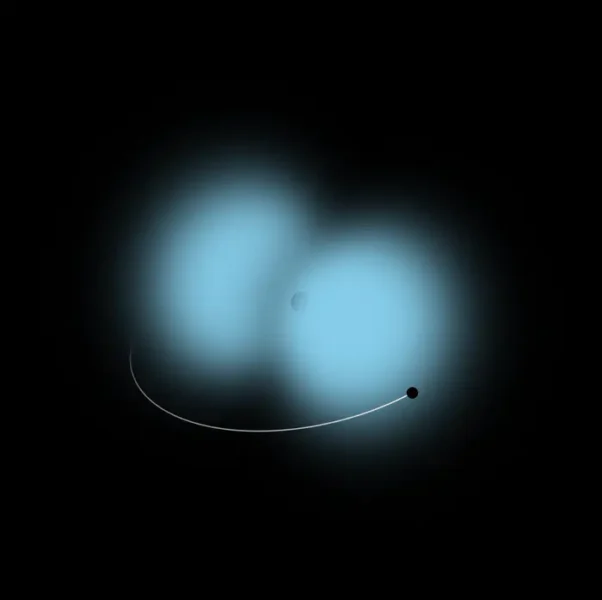Summary: A new study suggests that observing merging black hole pairs could provide evidence for the existence of ultralight particles, potentially solving mysteries in physics and cosmology.
Estimated reading time: 5 minutes
Physicists from the University of Amsterdam and the Niels Bohr Institute in Copenhagen have proposed a novel method for detecting new particles in nature. Their research, published in Physical Review Letters, suggests that carefully analyzing gravitational waves emitted during black hole mergers could unveil the presence of ultralight bosons – particles that have long eluded detection but could resolve several puzzles in astrophysics, cosmology, and particle physics.
Black Hole Superradiance: A Cosmic Particle Detector
The study builds on the concept of black hole superradiance, a phenomenon where rapidly spinning black holes can shed mass into a surrounding “cloud” of particles. This system, dubbed a “gravitational atom,” bears a striking resemblance to the electron cloud orbiting a proton in conventional atoms.
Superradiance is particularly efficient for particles much lighter than those currently measurable in terrestrial experiments. This unique property makes black holes potential cosmic detectors for ultralight bosons, a class of particles that could help explain various phenomena in the universe.
Two Possible Outcomes
The researchers identified two possible scenarios when observing binary black hole systems:
- Counter-rotating cloud: If the black holes and the particle cloud initially rotate in opposite directions, the cloud survives in its original state. This scenario would produce detectable ionization effects in the gravitational wave signal.
- Co-rotating cloud: In all other cases, resonant transitions destroy the cloud. However, this process leaves the binary’s orbit with very specific, measurable characteristics of eccentricity and inclination.
Both outcomes provide distinct signatures in gravitational wave signals, offering a novel search strategy for new particles.
Implications for Future Research
The findings open up exciting possibilities for upcoming gravitational wave observations. Advanced detectors like the Laser Interferometer Space Antenna (LISA) may be able to pick up the subtle signatures of these ultralight particles.
This research combines several discoveries made by University of Amsterdam scientists over the past six years, including:
- Resonant transitions: The particle cloud can “jump” between states, similar to electrons in an atom.
- Ionization: Parts of the cloud can be ejected from the system.
Both of these effects would leave distinctive marks on the gravitational waves emitted by merging black holes.
Challenges and Future Directions
While the research presents a promising avenue for particle detection, challenges remain. The signals produced by these ultralight bosons are likely to be extremely faint, requiring highly sensitive instruments and sophisticated data analysis techniques.
Additionally, distinguishing these signals from other astrophysical phenomena will be crucial. Researchers will need to carefully rule out alternative explanations for any observed anomalies in gravitational wave data.
Despite these hurdles, the potential payoff is enormous. The discovery of ultralight bosons could revolutionize our understanding of dark matter, help explain the accelerating expansion of the universe, and bridge gaps between quantum mechanics and general relativity.
As we enter a new era of gravitational wave astronomy, the dance of black holes may lead us to a deeper understanding of the fundamental particles that shape our universe.
Quiz
- What phenomenon allows black holes to potentially reveal the existence of ultralight bosons? a) Hawking radiation b) Black hole superradiance c) Gravitational lensing d) Accretion disk formation
- How many possible outcomes did the researchers identify for a binary black hole system with a particle cloud? a) One b) Two c) Three d) Four
- Which future instrument is mentioned as potentially being able to detect the signatures of ultralight bosons? a) James Webb Space Telescope b) Large Hadron Collider c) Laser Interferometer Space Antenna (LISA) d) Hubble Space Telescope
Answers:
- b) Black hole superradiance
- b) Two
- c) Laser Interferometer Space Antenna (LISA)
Further Reading:
Glossary of Terms:
- Ultralight bosons: Hypothetical particles with extremely low mass that could explain various phenomena in physics and cosmology.
- Superradiance: A process where rapidly rotating black holes can shed mass into a surrounding cloud of particles.
- Gravitational atom: A system consisting of a black hole and its surrounding particle cloud, analogous to an atomic nucleus and its electron cloud.
- Resonant transitions: The phenomenon where particles in a gravitational atom “jump” between energy states.
- Ionization: The process by which part of the particle cloud is ejected from the gravitational atom system.
- Gravitational waves: Ripples in spacetime caused by accelerating massive objects, such as merging black holes.
Enjoy this story? Get our newsletter! https://scienceblog.substack.com/


